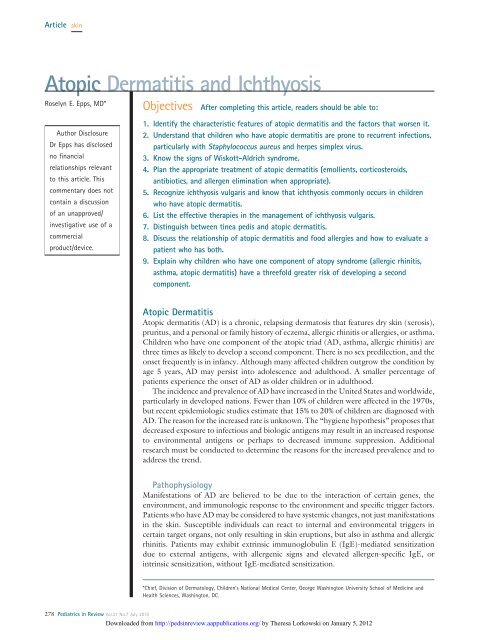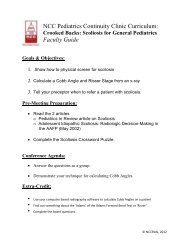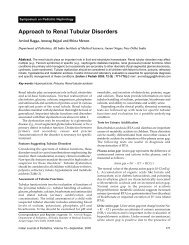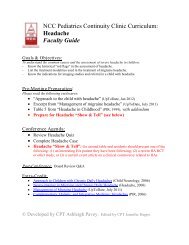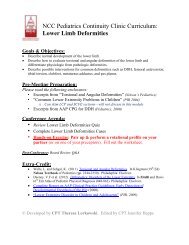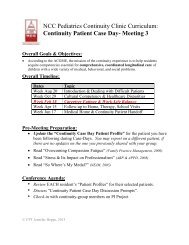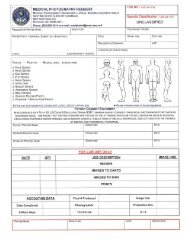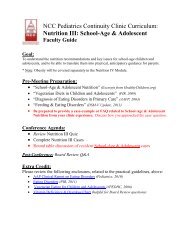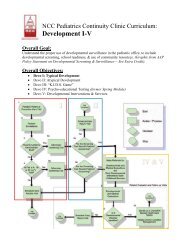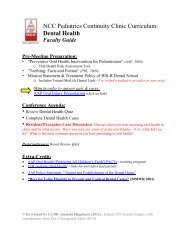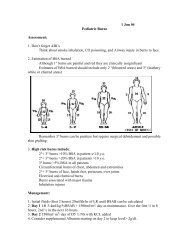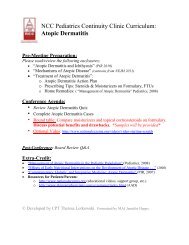NCC Pediatrics Continuity Clinic Curriculum: Atopic Dermatitis ...
NCC Pediatrics Continuity Clinic Curriculum: Atopic Dermatitis ...
NCC Pediatrics Continuity Clinic Curriculum: Atopic Dermatitis ...
Create successful ePaper yourself
Turn your PDF publications into a flip-book with our unique Google optimized e-Paper software.
Article skin<br />
<strong>Atopic</strong> <strong>Dermatitis</strong> and Ichthyosis<br />
Roselyn E. Epps, MD*<br />
Author Disclosure<br />
Dr Epps has disclosed<br />
no financial<br />
relationships relevant<br />
to this article. This<br />
commentary does not<br />
contain a discussion<br />
of an unapproved/<br />
investigative use of a<br />
commercial<br />
product/device.<br />
Objectives After completing this article, readers should be able to:<br />
1. Identify the characteristic features of atopic dermatitis and the factors that worsen it.<br />
2. Understand that children who have atopic dermatitis are prone to recurrent infections,<br />
particularly with Staphylococcus aureus and herpes simplex virus.<br />
3. Know the signs of Wiskott-Aldrich syndrome.<br />
4. Plan the appropriate treatment of atopic dermatitis (emollients, corticosteroids,<br />
antibiotics, and allergen elimination when appropriate).<br />
5. Recognize ichthyosis vulgaris and know that ichthyosis commonly occurs in children<br />
who have atopic dermatitis.<br />
6. List the effective therapies in the management of ichthyosis vulgaris.<br />
7. Distinguish between tinea pedis and atopic dermatitis.<br />
8. Discuss the relationship of atopic dermatitis and food allergies and how to evaluate a<br />
patient who has both.<br />
9. Explain why children who have one component of atopy syndrome (allergic rhinitis,<br />
asthma, atopic dermatitis) have a threefold greater risk of developing a second<br />
component.<br />
<strong>Atopic</strong> <strong>Dermatitis</strong><br />
<strong>Atopic</strong> dermatitis (AD) is a chronic, relapsing dermatosis that features dry skin (xerosis),<br />
pruritus, and a personal or family history of eczema, allergic rhinitis or allergies, or asthma.<br />
Children who have one component of the atopic triad (AD, asthma, allergic rhinitis) are<br />
three times as likely to develop a second component. There is no sex predilection, and the<br />
onset frequently is in infancy. Although many affected children outgrow the condition by<br />
age 5 years, AD may persist into adolescence and adulthood. A smaller percentage of<br />
patients experience the onset of AD as older children or in adulthood.<br />
The incidence and prevalence of AD have increased in the United States and worldwide,<br />
particularly in developed nations. Fewer than 10% of children were affected in the 1970s,<br />
but recent epidemiologic studies estimate that 15% to 20% of children are diagnosed with<br />
AD. The reason for the increased rate is unknown. The “hygiene hypothesis” proposes that<br />
decreased exposure to infectious and biologic antigens may result in an increased response<br />
to environmental antigens or perhaps to decreased immune suppression. Additional<br />
research must be conducted to determine the reasons for the increased prevalence and to<br />
address the trend.<br />
Pathophysiology<br />
Manifestations of AD are believed to be due to the interaction of certain genes, the<br />
environment, and immunologic response to the environment and specific trigger factors.<br />
Patients who have AD may be considered to have systemic changes, not just manifestations<br />
in the skin. Susceptible individuals can react to internal and environmental triggers in<br />
certain target organs, not only resulting in skin eruptions, but also in asthma and allergic<br />
rhinitis. Patients may exhibit extrinsic immunoglobulin E (IgE)-mediated sensitization<br />
due to external antigens, with allergenic signs and elevated allergen-specific IgE, or<br />
intrinsic sensitization, without IgE-mediated sensitization.<br />
*Chief, Division of Dermatology, Children’s National Medical Center, George Washington University School of Medicine and<br />
Health Sciences, Washington, DC.<br />
278 <strong>Pediatrics</strong> in Review Vol.31 No.7 July 2010<br />
Downloaded from http://pedsinreview.aappublications.org/ by Theresa Lorkowski on January 5, 2012


